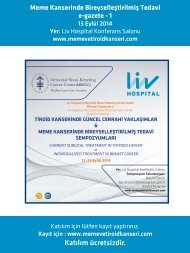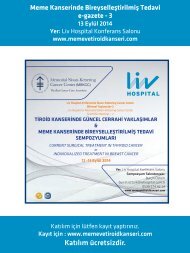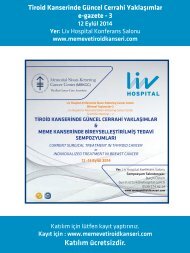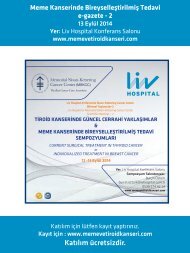ADVANCED ROBOTIC SURGERY CENTRE
You also want an ePaper? Increase the reach of your titles
YUMPU automatically turns print PDFs into web optimized ePapers that Google loves.
Which Operations Can Be<br />
Done with Robots?<br />
Although the increasingly widespread use of robotic surgery<br />
over the past decade has been concentrated on urologic<br />
surgery, it is now being ever more widely used in general,<br />
gynecological and heart surgery.<br />
Robotic Urology<br />
The prostate is a gland in the male system that plays a<br />
role in bladder output and semen viscosity. It is composed<br />
of secretive cells and peripheral tissue. Prostate cancer<br />
occurs with the abnormal development of these secretive<br />
cells. Unless diagnosed early, prostate cancer spreads to<br />
peripheral tissues via lymph and blood vessels. The areas<br />
to which it most commonly spreads (metastasis) are the<br />
peripheral lymph nodes and bones. It can also spread to the<br />
lungs, liver and other organs.<br />
There are various methods to treat prostate cancer. The<br />
most effective of these methods is radical prostatectomy.<br />
The 10-year disease-specific survival rate for patients<br />
with well differentiated tumors who have undergone<br />
radical prostatectomy is over 90%. For this reason, radical<br />
prostatectomy is the most preferred of all available<br />
treatment methods. Traditional open radical prostatectomy<br />
surgery is carried out with a large surgical incision. This<br />
means the patient experiences longer hospitalization time,<br />
a prolonged period of post-operation recovery and healing,<br />
exposure to a higher risk of infection and greater scarring.<br />
Robotic prostatectomy procedures that have become more<br />
widespread in recent years are performed with a small<br />
incision and offer the patient a less traumatic<br />
and minimally invasive alternative.
















